Are you curious about the social dynamics of tarantulas? Have you ever wondered how many tarantulas can live together without resorting to cannibalism? In this article, we will explore the fascinating world of tarantula group housing and uncover the truth behind this intriguing phenomenon.
Tarantulas are typically solitary creatures, known for their cannibalistic tendencies when in contact with other tarantulas. However, there are exceptions to this rule, such as the Monocentropus balfouri species from Socotra Island. These tarantulas have been successfully kept in groups, making them a rare case in the tarantula world. The balfouri tarantulas have stunning tan and blue coloration and are known to be docile. They can thrive in a dry climate with minimal humidity requirements, unlike many other tropical species. Other ground-dwelling tarantulas are generally not communal, but this species has shown good success in group housing. Additionally, balfouri spiderlings benefit from staying with their mother and even receive food from her.
Key Takeaways:
- Most tarantulas are solitary and cannibalistic, but the Monocentropus balfouri species can live together in groups.
- Balfouri tarantulas have stunning tan and blue coloration, are docile, and thrive in a dry climate.
- Group housing benefits balfouri spiderlings by allowing them to stay with their mother and receive food from her.
- Successful group housing requires careful consideration of space and monitoring of individual tarantula behaviors.
- The unique social dynamics of tarantulas offer a fascinating window into their natural behaviors and survival instincts.
How Many Tarantulas Can Live Together?
The Fascinating World of Tarantulas
Tarantulas are fascinating creatures with a wide variety of species, each with unique characteristics. While most tarantulas are solitary, some exhibit social behavior and can live together in groups. The Monocentropus balfouri species, in particular, stands out for its ability to thrive in a communal setup. This is rare among tarantulas, as they are typically cannibalistic and prefer isolation. However, balfouri tarantulas have shown success in group housing, providing a unique opportunity for keepers to observe their social interactions. Understanding the social behavior of tarantulas adds another layer of intrigue to the world of these fascinating arachnids.
Tarantula Social Behavior
While most tarantulas are solitary creatures, the Monocentropus balfouri species from Socotra Island has proven to be an exception. These tarantulas have successfully been kept in groups, challenging the notion that all tarantulas are cannibalistic and anti-social. By observing them in a communal setup, keepers have gained valuable insights into the social dynamics of these fascinating arachnids. tarantula social behavior
Unlike other ground-dwelling tarantulas, balfouri tarantulas have shown docile behavior and even exhibit maternal care towards their spiderlings. This species has beautiful tan and blue coloration, making them visually stunning additions to a tarantula collection. Their ability to thrive in dry climates and adapt to group housing sets them apart from many other tarantula species. tarantula communal living
Tarantula Communal Living
Communal living among tarantulas is a rare occurrence, as they are generally solitary creatures with cannibalistic tendencies. Each tarantula has its own territory and avoids contact with others. However, balfouri tarantulas have successfully formed communal groups, providing a unique opportunity to study their social behavior.
This communal setup requires careful monitoring and the adherence to specific guidelines to ensure the well-being of the tarantulas. Providing ample space is crucial, as overcrowding can lead to stress and aggression. Keeping the tarantulas well-fed is essential to minimize the risk of cannibalism, as hunger can trigger predatory behavior. By observing the group dynamics and individual behaviors, keepers can create a harmonious communal environment for these exceptional tarantulas.
Exploring the world of tarantulas reveals a captivating variety of species, each with its own intriguing behaviors. The Monocentropus balfouri tarantulas defy the stereotype of solitary and cannibalistic tarantulas, showcasing their ability to live harmoniously in groups. Their social interactions and unique coloration make them a captivating subject for tarantula enthusiasts and researchers alike.
How Tarantulas Are Typically Housed
Tarantulas are fascinating creatures to keep as pets, but their housing needs careful consideration. In general, tarantulas are housed individually to avoid cannibalism and ensure their safety. When kept as pets, tarantulas are typically housed in their own enclosures and only come in contact with others of their species during breeding attempts. However, some species of tree-dwelling tarantulas have been successfully kept together in larger enclosures, but these setups require ample space and careful monitoring to prevent aggression and cannibalism. keeping multiple tarantulas as pets
It’s important to note that tarantulas are not highly social creatures, so keeping multiple individuals together should be approached with caution. Tarantulas are known for their cannibalistic tendencies, and even during mating, there is a risk of the male being eaten by the female. Therefore, if you are considering housing multiple tarantulas together, it’s crucial to provide enough space and hiding places to minimize aggression and stress.
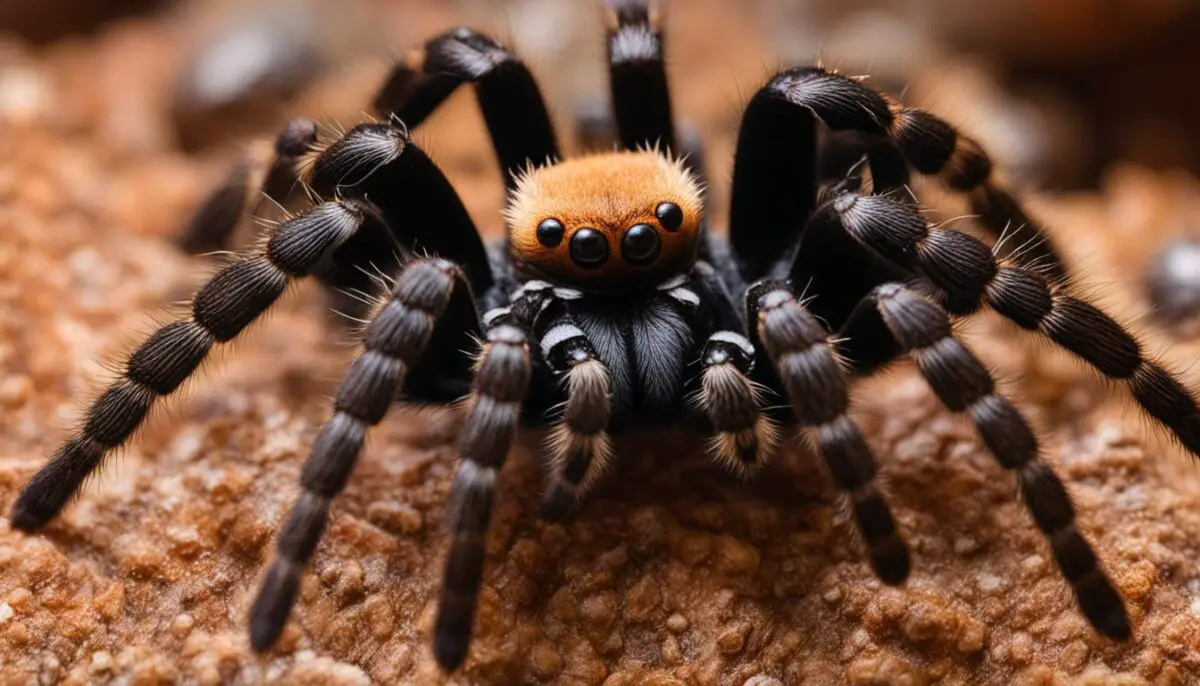
Factors to Consider for Tarantula Socialization
When deciding to keep multiple tarantulas together, there are a few factors to consider. First, it’s important to ensure that the tarantulas you plan to house together are of the same species and similar in size. Mixing different species or size differences can lead to aggression and potential harm to the smaller or weaker tarantula.
Second, providing a spacious enclosure with enough hiding places and separate retreat areas can help reduce stress and minimize territorial disputes. It’s crucial to create an environment that allows each tarantula to establish its own space and retreat when needed. The enclosure should also have proper ventilation and maintain appropriate temperature and humidity levels to promote optimal health and well-being. tarantula tankmates
Lastly, regular monitoring of the tarantulas’ behaviors and interactions is essential. Observing their feeding habits, aggression levels, and any signs of stress or illness can help you identify and address any issues that may arise. If any signs of aggression or cannibalism are observed, it’s important to separate the tarantulas immediately to prevent harm.
The Unique Case of Monocentropus Balfouri
The Monocentropus balfouri tarantulas from Socotra Island present a unique case of communal living within the tarantula world. While tarantulas are typically solitary and cannibalistic, the balfouri species has shown success in group housing. However, establishing a communal setup requires careful consideration and adherence to specific guidelines to ensure the well-being of the tarantulas.
When housing multiple balfouri tarantulas together, it is crucial to provide ample space to prevent overcrowding and minimize stress and aggression. Observing group dynamics and monitoring individual behaviors is essential to maintaining a harmonious communal environment. Keeping tarantulas well-fed is also important, as hunger can trigger predatory behavior and increase the risk of cannibalism. tarantula socialization
Creating a suitable habitat for communal tarantulas involves selecting the right substrate for burrowing, providing hiding places like cork bark or driftwood, and choosing an appropriate enclosure that meets the tarantulas’ size and space requirements. Proper enclosure design and substrate selection are crucial for the tarantulas’ psychological well-being and overall success in a communal setup.
| Guidelines for Tarantula Colony Setup | |
|---|---|
| 1. Provide ample space to prevent overcrowding | 4. Observe group dynamics and monitor behaviors |
| 2. Keep tarantulas well-fed to reduce cannibalism | 5. Select suitable enclosures and substrates |
| 3. Avoid mixing incompatible tarantula species | 6. Ensure proper ventilation and security |
“Creating a harmonious communal environment for tarantulas involves understanding their social dynamics and providing the necessary resources for their well-being. By adhering to guidelines and closely monitoring their behavior, keepers can successfully house multiple Monocentropus balfouri tarantulas together.”
The Role of Substrate and Enclosure Design
Creating an appropriate enclosure for tarantulas is crucial to their well-being and success in a communal setup. One important aspect of enclosure design is choosing the right substrate. The substrate should support burrowing behavior, especially for species like the Monocentropus balfouri tarantulas. One recommended substrate is the Lugarti Premium Tarantula Substrate, known for its ability to provide a suitable environment for burrowing tarantulas. tarantula colony guidelines
Additionally, it is important to provide hiding places in the enclosure for the psychological well-being of the tarantulas. Cork bark and driftwood are commonly used as hiding spots, allowing the tarantulas to feel secure and comfortable in their habitat. These hiding places also provide opportunities for the tarantulas to exhibit natural behaviors such as web-building and exploration.
When selecting an enclosure, size and space requirements should be considered. Glass terrariums with sliding and locking screen tops are often preferred because they provide proper ventilation and security for the tarantulas. The size of the enclosure should be appropriate for the species, allowing the tarantulas to move and explore their environment without feeling cramped or stressed.
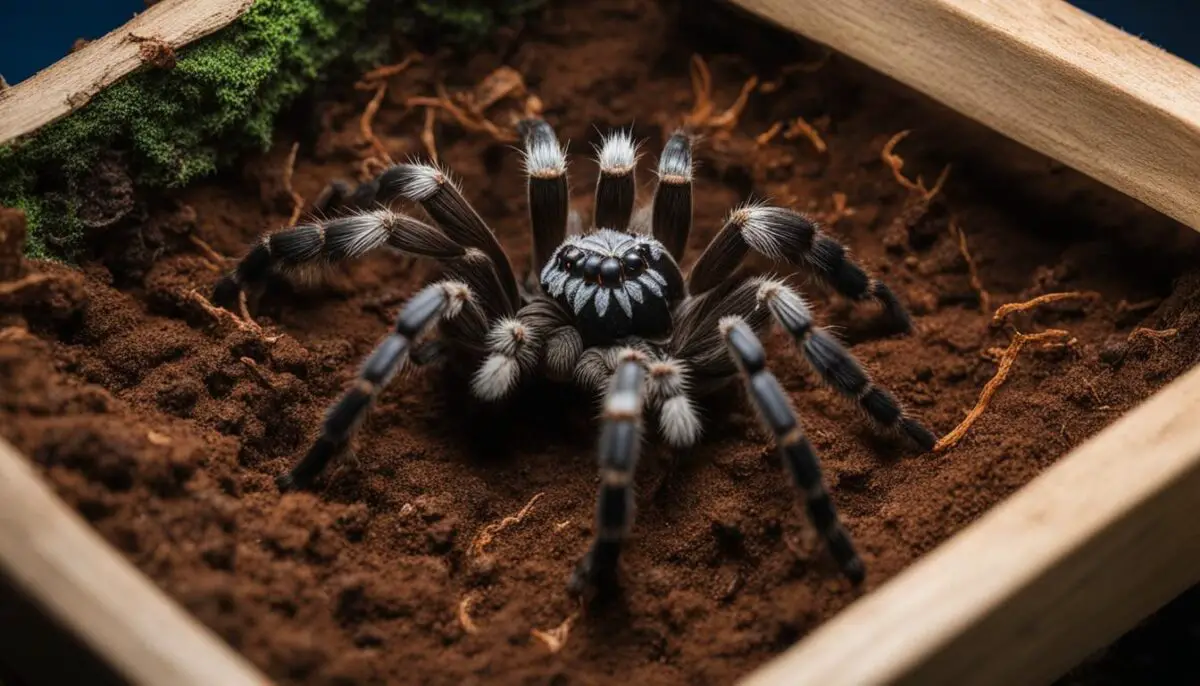
Recommended Substrate for Tarantula Enclosures:
| Substrate Type | Description |
|---|---|
| Lugarti Premium Tarantula Substrate | A high-quality substrate that provides excellent moisture retention and allows for easy burrowing |
| Cocofiber | A popular choice that creates a naturalistic environment and retains moisture well |
| Peat Moss | Provides good moisture retention and is suitable for species that require higher humidity levels |
By carefully selecting the substrate and designing the enclosure to meet the tarantulas’ habitat requirements, keepers can provide a suitable and comfortable environment for their communal tarantula setups. This attention to detail and consideration of the tarantulas’ needs can contribute to their overall well-being and success in group housing.
Tarantula Parenting Behavior
Tarantula mothers exhibit fascinating parenting behaviors, especially when it comes to caring for their egg sacs. They take great care in guarding and protecting their eggs, ensuring their survival and development. Some species, such as the Monocentropus balfouri, even turn their egg sacs a few times a day to aid in proper development. However, there is also a risk of cannibalism of the egg sac or the spiderlings themselves, which adds an element of mystery to their maternal behavior.
One interesting approach some tarantula owners take to prevent cannibalism is to remove the egg sacs from the mothers. By doing so, they ensure the survival of the spiderlings and eliminate the risk of cannibalistic behavior. This practice requires careful handling and proper knowledge of tarantula care to ensure the successful hatching and raising of the spiderlings.
Understanding tarantula maternal behavior and the complexities of their egg sac care adds another layer of intrigue to these captivating creatures. While there is still much to learn about tarantula parenting, it is clear that they exhibit unique and fascinating behaviors that contribute to the wonder of the natural world.
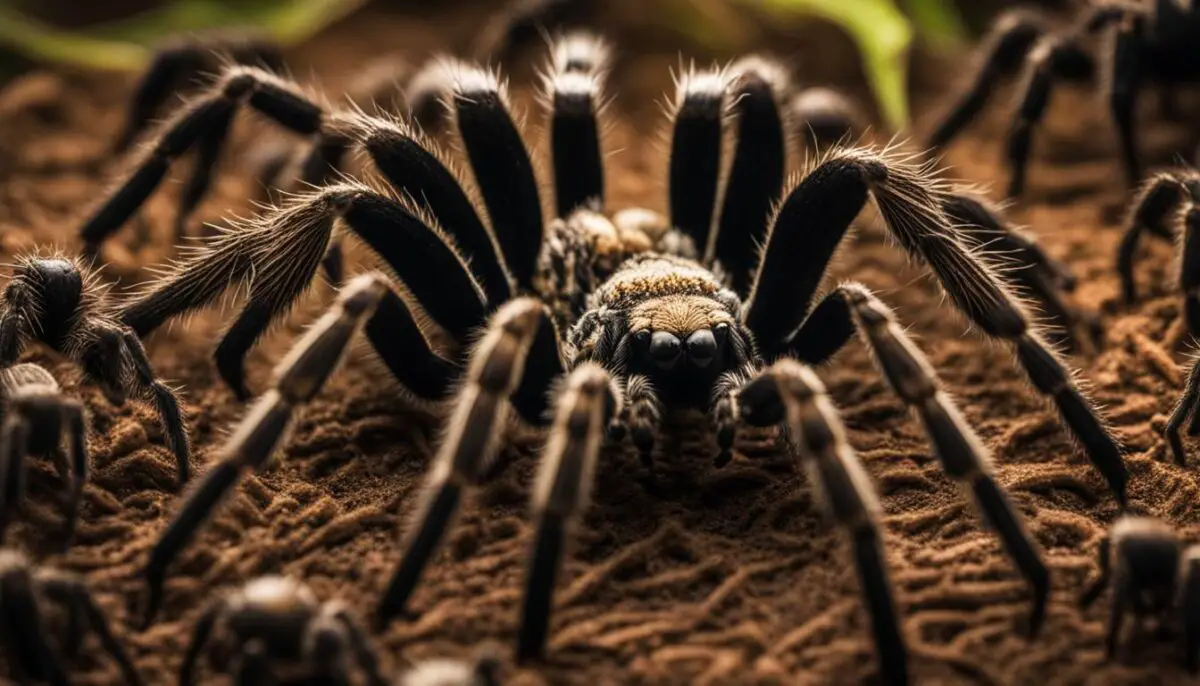
| Tarantula Parenting Behavior | Insights |
|---|---|
| Tarantula mothers guard their egg sacs | They exhibit behavior to protect their offspring |
| Some tarantulas turn their egg sacs | It aids in the proper development of the eggs |
| Cannibalism of the egg sac or spiderlings can occur | It adds mystery to their maternal behavior |
| Some owners remove the egg sacs | It ensures the survival of the spiderlings |
Extraordinary Spider Mothering
Spiders exhibit fascinating maternal behaviors that showcase their dedication and sacrifice for their offspring. One example is the black lace weaver spider, which goes to extraordinary lengths to ensure the survival of her young. After her spiderlings emerge from the egg sac, the mother allows them to feed off her body, ultimately sacrificing herself to nourish and sustain her offspring. This selflessness is an instinctual part of the spider’s life cycle and highlights their remarkable maternal behavior.
Another notable spider species that demonstrates exceptional mothering is the wolf spider. These spiders carry their hundreds of spiderlings on their backs, providing care and protection until they are ready to venture out on their own. This display of parental care is not only impressive but also essential for the survival and development of the spiderlings. The wolf spider’s dedication to its young showcases the complexity and adaptability of spider maternal behavior.
“Spiders exhibit extraordinary maternal behaviors, sacrificing themselves for the sake of their offspring.”
These extraordinary spider mothers demonstrate a level of selflessness and dedication that is awe-inspiring. Their behaviors shed light on the intricate dynamics of spider populations and the importance of maternal care in their survival. Understanding and appreciating these remarkable spider maternal behaviors can help us develop a deeper respect for these often misunderstood creatures.
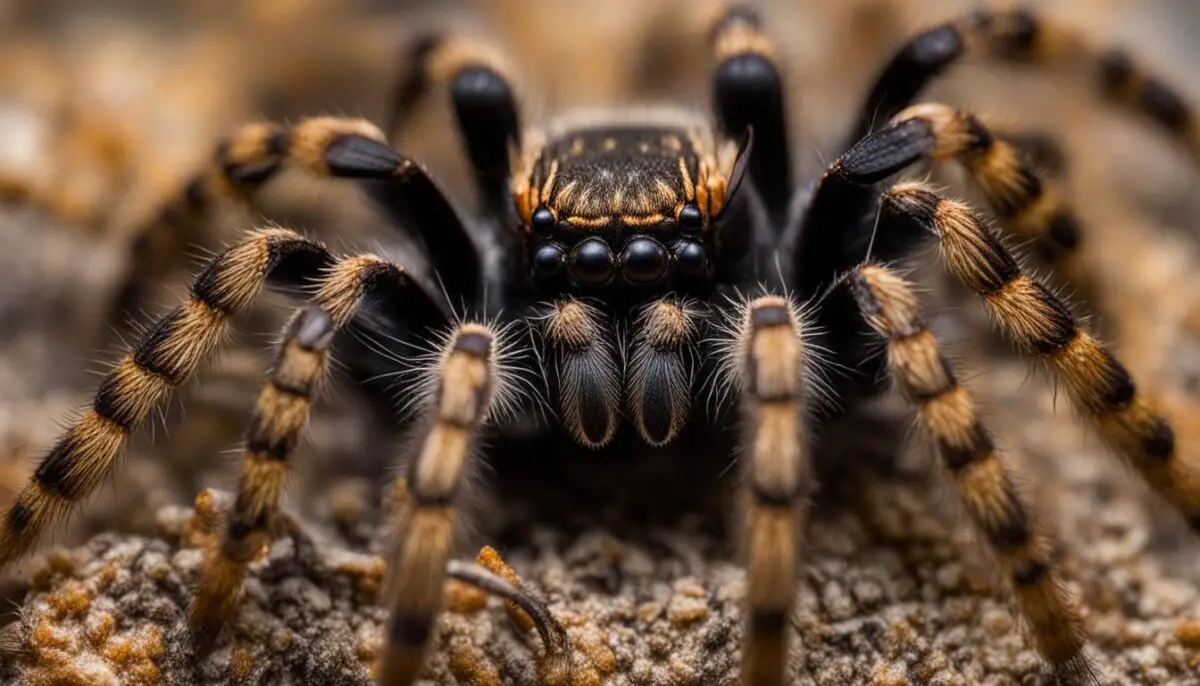
| Spider Species | Maternal Behavior |
|---|---|
| Black Lace Weaver Spider | Allows spiderlings to feed off her body, sacrificing herself to nourish them. |
| Wolf Spider | Carries spiderlings on her back, providing care and protection until they are ready to venture out on their own. |
These examples of spider maternal behavior offer a glimpse into the diverse and intriguing world of arachnids. Their selflessness and dedication to their offspring highlight the complex behaviors and survival strategies that spiders have developed over millions of years. By studying and appreciating these extraordinary spider mothers, we gain a greater understanding of the natural world and the unique adaptations found within it.
Overcoming Fear and Misconceptions
Many people have an initial fear or discomfort around tarantulas and spiders in general. This fear is often based on misconceptions perpetuated by the media and lack of close interactions. However, once individuals overcome their preconceived notions and get a closer look, they can discover the beauty and fascinating behaviors of tarantulas and spiders. Tarantulas are agile creatures capable of astonishing feats, and their unique characteristics make them captivating subjects for observation. Educating oneself about spiders and debunking myths can help dispel fear and foster appreciation for these misunderstood creatures. tarantula cohabitation tips
One common misconception is that tarantulas are dangerous and venomous. While it’s true that tarantulas possess venom, their bite is usually not harmful to humans. Most species are docile and only bite when threatened or provoked. Tarantulas would rather retreat and hide than engage in aggressive behavior. It’s important to remember that tarantulas are not out to harm us and pose little to no risk when handled with care.
“The only thing we have to fear is fear itself.” – Franklin D. Roosevelt
Another myth surrounding tarantulas is their perceived aggressiveness. Contrary to popular belief, tarantulas are not aggressive creatures by nature. They prefer to live solitary lives and avoid conflicts with other animals, including humans. Tarantulas generally only display defensive behaviors when they feel threatened or cornered. tarantula group dynamics
By educating ourselves and others about the true nature of tarantulas and spiders, we can overcome the fear and hesitation that surrounds them. With a better understanding of their behavior and by challenging misconceptions, we can appreciate these remarkable creatures for the important role they play in our ecosystem.

Debunking Common Spider Myths:
- Spiders are not out to attack or bite humans.
- Most spider species are harmless and play a vital role in controlling insect populations.
- Spiders are not inherently aggressive and prefer to avoid confrontation.
- Spider bites are rare and are usually only a defensive response when threatened.
- Tarantulas are not dangerous to humans and their venom is typically not harmful.
Common Myths vs. Reality:
| Myth | Reality |
|---|---|
| Spiders are vicious and attack people. | Spiders are generally docile and avoid confrontations. |
| All spiders are venomous and pose a threat to humans. | Most spider bites are harmless and only cause mild irritation. |
| Tarantulas are aggressive and should be feared. | Tarantulas are typically calm and prefer to retreat rather than attack. |
| Spiders are dirty and carry diseases. | Spiders are clean creatures and do not transmit diseases to humans. |
The Benefits of Tarantula Keeping
Keeping tarantulas as pets offers a wealth of benefits for enthusiasts. Beyond the initial fear and misconceptions that may surround these fascinating creatures, tarantulas can provide a unique and rewarding pet-keeping experience. Their low maintenance requirements make them accessible to a wide range of individuals, while their captivating behaviors and natural survival instincts offer endless opportunities for observation and study.
As pets, tarantulas require minimal care once their habitat is properly set up. They can be safely housed in standard terrariums, with enclosure design and substrate selection tailored to their specific needs. Watching tarantulas go about their daily activities, from hunting techniques to reproductive habits, allows keepers to gain insights into the natural world and appreciate the complexity of these misunderstood creatures. By observing their behaviors, keepers can also better understand the ecological role that tarantulas play in their native environments.
Aside from personal enjoyment, keeping tarantulas as pets can also contribute to broader conservation efforts. By supporting organizations dedicated to preserving tarantula habitats and participating in captive breeding programs, keepers can play a role in protecting these unique creatures for future generations. Through responsible practices and education, we can ensure that tarantulas continue to thrive in the wild and captivate our imaginations for years to come.
Table: Comparing Tarantula Care Requirements
| Aspect | Tarantulas | Other Pets |
|---|---|---|
| Feeding Frequency | Varies by species, typically once a week | Varies by species, ranging from multiple times a day to once a day |
| Space Requirements | Relatively small enclosure size | Varies by species, often larger enclosures needed |
| Social Interaction | Minimal, solitary creatures | Varies by species, some require socialization |
| Specialized Equipment | Terrarium, substrate, hiding places | Varies by species, may require specialized habitats, toys, and accessories |
| Exercise Needs | Low, minimal physical activity | Varies by species, often need regular exercise and play |
Table: Comparing Tarantula Care Requirements
“Keeping tarantulas as pets can be a deeply rewarding experience. Their unique behaviors and low maintenance requirements make them an ideal choice for those looking for an alternative and intriguing pet. By responsibly caring for tarantulas and promoting conservation efforts, we can appreciate these creatures while contributing to their preservation.”
– Tarantula enthusiast
Encouraging Tarantula Conservation
Conservation efforts play a vital role in protecting tarantulas and their habitats. By understanding the importance of conservation and taking active measures, we can contribute to the preservation of these captivating creatures for future generations. Here are some ways we can encourage tarantula conservation:
- Support conservation organizations: There are various organizations dedicated to protecting tarantula habitats and promoting sustainable practices. By supporting these organizations through donations or volunteering, we can contribute directly to conservation efforts.
- Practice ethical acquisition: When acquiring tarantulas, it is important to ensure that they are obtained ethically. This means avoiding purchasing from illegal wildlife trade and supporting responsible breeders who prioritize the well-being of the tarantulas.
- Participate in captive breeding programs: Captive breeding programs help reduce the demand for wild-caught tarantulas. By responsibly breeding tarantulas in captivity, we can help ensure the survival of the species while minimizing the impact on wild populations.
- Spread awareness: Educating others about the importance of tarantula conservation can help raise awareness and inspire action. Sharing information through social media, organizing local events, or even writing articles can contribute to spreading the message and mobilizing more people to support conservation efforts.
By actively engaging in tarantula conservation, we can make a significant difference in the preservation of these fascinating creatures. Tarantulas not only contribute to the biodiversity of our planet but also offer valuable insights into the natural world. Let’s come together to protect their habitats, ensure their well-being, and appreciate the unique role they play in our ecosystem.
Table: Tarantula Conservation Organizations
| Organization | Mission | Website |
|---|---|---|
| Tarantula Conservancy | Preserving tarantula habitats and raising awareness about tarantula conservation | www.tarantulaconservancy.org |
| Arachnology Society | Supporting arachnological research and conservation efforts | www.arachnology.org |
| World Wildlife Fund (WWF) | Working to conserve biodiversity and protect endangered species, including tarantulas | www.worldwildlife.org |
Conclusion
Tarantulas are captivating creatures with a wide range of behaviors and characteristics. While most tarantulas are solitary and cannibalistic, the Monocentropus balfouri species from Socotra Island has proven to be an exception, thriving in group housing. Creating suitable environments and monitoring tarantula behaviors are key to successful communal setups.
Tarantula mothers exhibit unique parenting behaviors, guarding and caring for their egg sacs and spiderlings. Other spider species also demonstrate fascinating mothering behaviors, sacrificing themselves for the sake of their offspring. Overcoming fear and misconceptions about spiders can lead to a greater appreciation for these intriguing creatures.
Keeping tarantulas as pets offers not only the opportunity for personal observation and enjoyment, but also the potential for contributing to tarantula conservation efforts. By understanding and respecting these creatures, we can ensure the preservation of their habitats and populations for generations to come.
FAQ
How many tarantulas can live together?
Most tarantulas are solitary creatures and are typically housed individually to avoid cannibalism and ensure their safety. However, some species, like the Monocentropus balfouri, have been successfully kept in groups.
What is the Monocentropus balfouri species?
The Monocentropus balfouri is a tarantula species from Socotra Island that exhibits communal living behavior, making it a rare case in the tarantula world.
How should tarantulas typically be housed?
Tarantulas are usually housed individually to prevent cannibalism. They are typically kept in their own enclosures and only come in contact with others of their species during breeding attempts.
Can tarantulas live together in larger enclosures?
Some species of tree-dwelling tarantulas have been successfully kept together in larger enclosures, but careful monitoring and ample space are required to prevent aggression and cannibalism.
What are the guidelines for housing Monocentropus balfouri tarantulas together?
When housing Monocentropus balfouri tarantulas together, it is important to provide ample space, ensure they are well-fed to reduce cannibalistic tendencies, and carefully observe group dynamics and individual behaviors.
What substrate and enclosure design is suitable for tarantulas?
Choosing the right substrate is important, and the Lugarti Premium Tarantula Substrate has been recommended for burrowing tarantulas. Providing hiding places like cork bark and driftwood is also essential. Glass terrariums with sliding and locking screen tops are often preferred.
How do tarantula mothers behave towards their offspring?
Tarantula mothers exhibit unique parenting behaviors, guarding and becoming highly defensive over their eggs and even turning their egg sacs to aid in proper development. Some tarantula owners choose to remove the egg sacs to prevent cannibalism.
What are some examples of extraordinary spider maternal behavior?
The black lace weaver spider sacrifices her own life for the sake of her offspring, allowing them to feed off her body. Wolf spiders carry their spiderlings on their backs, providing care and protection until they are ready to venture on their own.
How can fear and misconceptions about tarantulas and spiders be overcome?
By educating oneself about spiders and debunking myths, individuals can discover the beauty and fascinating behaviors of tarantulas and spiders, helping to dispel fear and foster appreciation for these misunderstood creatures.
What are the benefits of keeping tarantulas as pets?
Tarantulas are low maintenance pets that offer the opportunity to observe their behaviors and natural survival instincts. They can be safely housed in standard terrariums and provide unique insights into the natural world.
How can individuals encourage tarantula conservation?
Supporting organizations dedicated to preserving tarantula habitats and promoting sustainable practices, as well as adhering to ethical practices in acquiring tarantulas and participating in captive breeding programs, can help protect these creatures and their habitats.
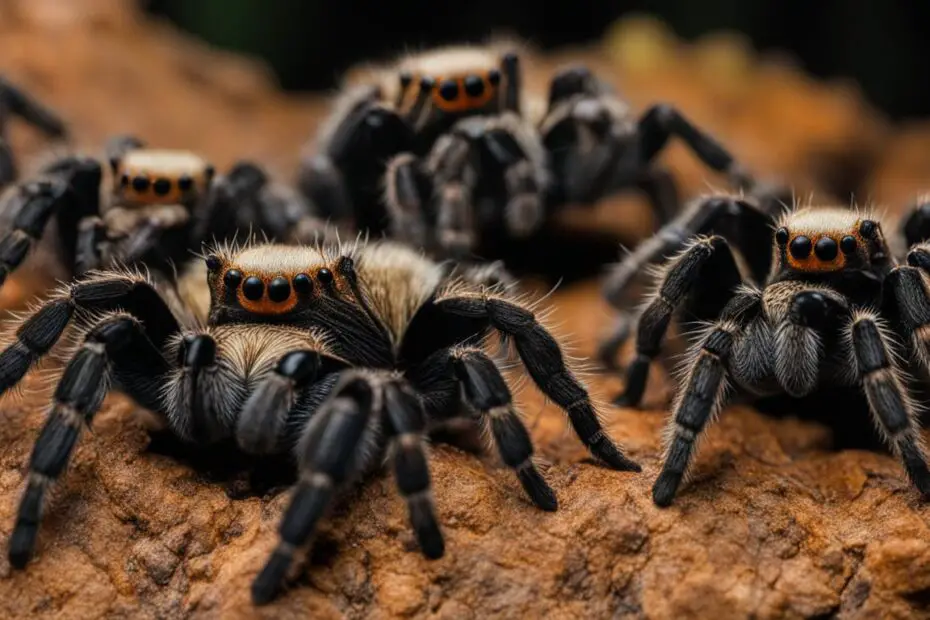

It’s an awesome piece of writing designed for all the online viewers; they will get advantage from it I am sure.
I like looking through a post that can make men and women think.
Also, thanks for permitting me to comment!
Hi there! Someone in my Facebook group shared this website with us so I came to take a look. I’m definitely enjoying the information. I’m bookmarking and will be tweeting this to my followers! Outstanding blog and brilliant style and design.